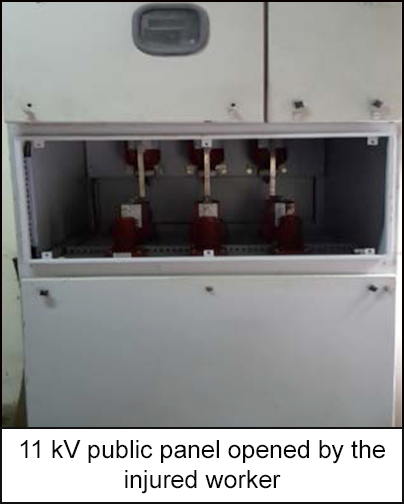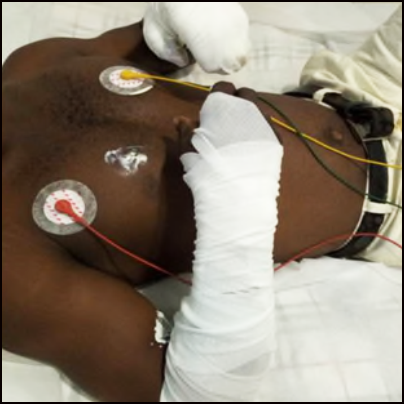-
What happened?
During a local power failure, electrical power to the building was supplied by the standby generator.
Power was restored to the neighbourhood, but the automatic changeover switch failed to restore power to the entire building.
The operator turned off the standby generator manually, but power failed to restore, and the generator could not be put back in service.
A technician opened and removed the front cover of the 11 kV (medium voltage) metering panel (owned by the local electricity distribution company) to observe the fault.
As his hands were within the magnetic field, an electric spark occurred. He received an electric shock, and was found on the ground with his left palm and right arm badly burnt. He was rescued and taken to the company clinic for medical attention.

-
Why did it happen?
Power sources (generator and public) were live when the panel was opened. There was no permit to work and no electrical isolation.
There was no inter-lock system on the 11KV power panel. Panel could be easily opened.
Technician did not have electrical accreditation and did not request a permit to work.
Troubleshooting of the problem immediately without consultation. No risk assessment carried out.
‘Danger’ warning instruction inside the room, but no ‘Do not open’ sign on the panel itself.
Technician was alone when the incident occurred.
No personal protective equipment (PPE) was available in the medium/low voltage rooms. Technician was not wearing appropriate PPE for electrical intervention.

-
What did they learn?
Provide inter-lock systems on all medium and high voltage public meter panel at all locations.
Provide electrical PPE and rescue kits in electrical rooms.
Post signage on 11 kV public power panels: ‘Do not open’.
Post signage on all electrical room doors stating ‘Access restricted to only authorised personnel’ and ‘Permit to work required for any intervention in this room’.
Provide clear procedure on electrical authorisation levels for all personnel. Make them available in all electrical rooms.
Provide training and awareness on permit to work and isolation procedures.
Ensure electrical technicians are qualified.
Provide induction training for all electrical technicians on their responsibilities and limitations.
Give electrical authorisation training to all electrical technicians.

-
Ask yourself or your crew
How can something like this happen here?
Think of a time you or a colleague tried to troubleshoot an electrical problem. What were the risks?
What PPE is available for electrical tasks? Is it readily available? When should it be worn?
What is the process for authorising electrical interventions?
What else can we learn from this incident?

Add to homescreen
Content name
Select existing category:
Content name
New collection
Edit collection
What happened?
During a local power failure, electrical power to the building was supplied by the standby generator.
Power was restored to the neighbourhood, but the automatic changeover switch failed to restore power to the entire building.
The operator turned off the standby generator manually, but power failed to restore, and the generator could not be put back in service.
A technician opened and removed the front cover of the 11 kV (medium voltage) metering panel (owned by the local electricity distribution company) to observe the fault.
As his hands were within the magnetic field, an electric spark occurred. He received an electric shock, and was found on the ground with his left palm and right arm badly burnt. He was rescued and taken to the company clinic for medical attention.

Why did it happen?
Power sources (generator and public) were live when the panel was opened. There was no permit to work and no electrical isolation.
There was no inter-lock system on the 11KV power panel. Panel could be easily opened.
Technician did not have electrical accreditation and did not request a permit to work.
Troubleshooting of the problem immediately without consultation. No risk assessment carried out.
‘Danger’ warning instruction inside the room, but no ‘Do not open’ sign on the panel itself.
Technician was alone when the incident occurred.
No personal protective equipment (PPE) was available in the medium/low voltage rooms. Technician was not wearing appropriate PPE for electrical intervention.

What did they learn?
Provide inter-lock systems on all medium and high voltage public meter panel at all locations.
Provide electrical PPE and rescue kits in electrical rooms.
Post signage on 11 kV public power panels: ‘Do not open’.
Post signage on all electrical room doors stating ‘Access restricted to only authorised personnel’ and ‘Permit to work required for any intervention in this room’.
Provide clear procedure on electrical authorisation levels for all personnel. Make them available in all electrical rooms.
Provide training and awareness on permit to work and isolation procedures.
Ensure electrical technicians are qualified.
Provide induction training for all electrical technicians on their responsibilities and limitations.
Give electrical authorisation training to all electrical technicians.

Ask yourself or your crew
How can something like this happen here?
Think of a time you or a colleague tried to troubleshoot an electrical problem. What were the risks?
What PPE is available for electrical tasks? Is it readily available? When should it be worn?
What is the process for authorising electrical interventions?
What else can we learn from this incident?
A technician received electric shock and burns when opening an 11 kV panel. He was not authorised and the power was not isolated.













